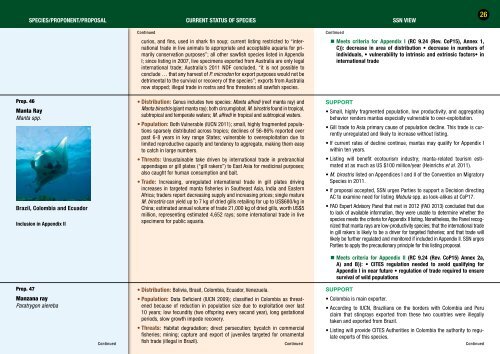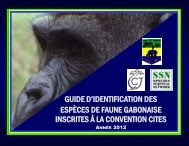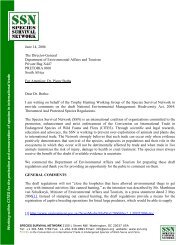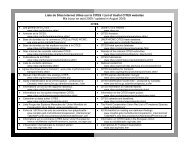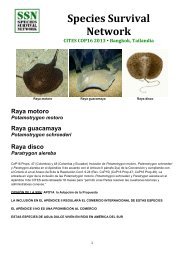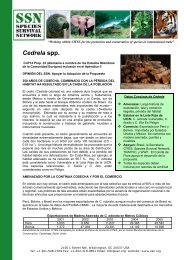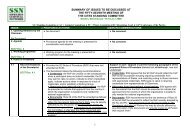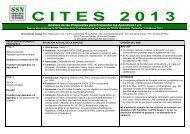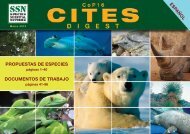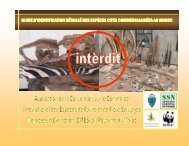CITES CoP16 Digest - Species Survival Network
CITES CoP16 Digest - Species Survival Network
CITES CoP16 Digest - Species Survival Network
You also want an ePaper? Increase the reach of your titles
YUMPU automatically turns print PDFs into web optimized ePapers that Google loves.
SPECIES/PROPONENT/PROPOSAL CURRENT STATUS OF SPECIES SSN VIEW<br />
26<br />
Prop. 46<br />
Manta Ray<br />
Manta spp.<br />
Brazil, Colombia and Ecuador<br />
Inclusion in Appendix II<br />
Continued<br />
curios, and fins, used in shark fin soup; current listing restricted to “international<br />
trade in live animals to appropriate and acceptable aquaria for primarily<br />
conservation purposes”; all other sawfish species listed in Appendix<br />
I; since listing in 2007, live specimens exported from Australia are only legal<br />
international trade; Australia’s 2011 NDF concluded, “it is not possible to<br />
conclude … that any harvest of P. microdon for export purposes would not be<br />
detrimental to the survival or recovery of the species”; exports from Australia<br />
now stopped; illegal trade in rostra and fins threatens all sawfish species.<br />
• Distribution: Genus includes two species: Manta alfredi (reef manta ray) and<br />
Manta birostris (giant manta ray); both circumglobal; M. birostris found in tropical,<br />
subtropical and temperate waters; M. alfredi in tropical and subtropical waters.<br />
• Population: Both Vulnerable (IUCN 2011); small, highly fragmented populations<br />
sparsely distributed across tropics; declines of 56-86% reported over<br />
past 6-8 years in key range States; vulnerable to overexploitation due to<br />
limited reproductive capacity and tendency to aggregate, making them easy<br />
to catch in large numbers.<br />
• Threats: Unsustainable take driven by international trade in prebranchial<br />
appendages or gill plates (“gill rakers”) to East Asia for medicinal purposes;<br />
also caught for human consumption and bait.<br />
• Trade: Increasing, unregulated international trade in gill plates driving<br />
increases in targeted manta fisheries in Southeast Asia, India and Eastern<br />
Africa; traders report decreasing supply and increasing prices; single mature<br />
M. birostris can yield up to 7 kg of dried gills retailing for up to US$680/kg in<br />
China; estimated annual volume of trade 21,000 kg of dried gills, worth US$5<br />
million, representing estimated 4,652 rays; some international trade in live<br />
specimens for public aquaria.<br />
Continued<br />
• Meets criteria for Appendix I (RC 9.24 (Rev. CoP15), Annex 1,<br />
C)): decrease in area of distribution • decrease in numbers of<br />
individuals, • vulnerability to intrinsic and extrinsic factors• in<br />
international trade<br />
SUPPORT<br />
• Small, highly fragmented population, low productivity, and aggregating<br />
behavior renders mantas especially vulnerable to over-exploitation.<br />
• Gill trade to Asia primary cause of population decline. This trade is currently<br />
unregulated and likely to increase without listing.<br />
• If current rates of decline continue, mantas may qualify for Appendix I<br />
within ten years.<br />
• Listing will benefit ecotourism industry; manta-related tourism estimated<br />
at as much as US $100 million/year (Heinrichs et al. 2011).<br />
• M. birostris listed on Appendices I and II of the Convention on Migratory<br />
<strong>Species</strong> in 2011.<br />
• If proposal accepted, SSN urges Parties to support a Decision directing<br />
AC to examine need for listing Mobula spp. as look-alikes at CoP17.<br />
• FAO Expert Advisory Panel that met in 2012 (FAO 2013) concluded that due<br />
to lack of available information, they were unable to determine whether the<br />
species meets the criteria for Appendix II listing. Nonetheless, the Panel recognized<br />
that manta rays are low-productivity species; that the international trade<br />
in gill rakers is likely to be a driver for targeted fisheries; and that trade will<br />
likely be further regulated and monitored if included in Appendix II. SSN urges<br />
Parties to apply the precautionary principle for this listing proposal.<br />
• Meets criteria for Appendix II (RC 9.24 (Rev. CoP15) Annex 2a,<br />
A) and B)): • <strong>CITES</strong> regulation needed to avoid qualifying for<br />
Appendix I in near future • regulation of trade required to ensure<br />
survival of wild populations<br />
Prop. 47<br />
Manzana ray<br />
Paratrygon aiereba<br />
• Distribution: Bolivia, Brasil, Colombia, Ecuador, Venezuela.<br />
• Population: Data Deficient (IUCN 2009); classified in Colombia as threatened<br />
because of reduction in population size due to exploitation over last<br />
10 years; low fecundity (two offspring every second year), long gestational<br />
periods, slow growth impede recovery.<br />
• Threats: Habitat degradation; direct persecution; bycatch in commercial<br />
fisheries; mining; capture and export of juveniles targeted for ornamental<br />
fish trade (illegal in Brazil).<br />
SUPPORT<br />
• Colombia is main exporter.<br />
• According to IUCN, Brazilians on the borders with Colombia and Peru<br />
claim that stingrays exported from these two countries were illegally<br />
taken and exported from Brazil.<br />
• Listing will provide <strong>CITES</strong> Authorities in Colombia the authority to regulate<br />
exports of this species.<br />
Continued Continued Continued


